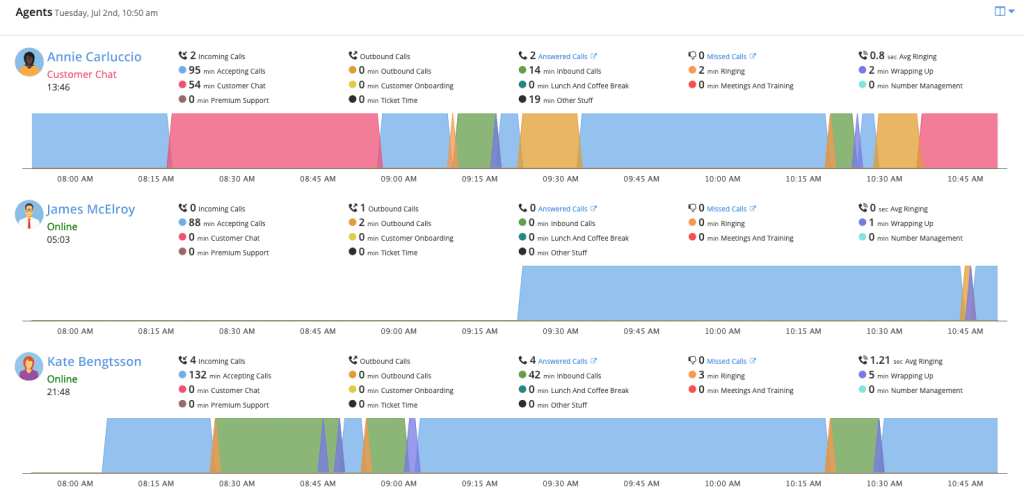Scaling Your Call Center with Confidence: 3 Best Practices for Managing Remote Agents
Developing and motivating an effective sales/service workforce is complex even when your agents are onsite; when the call center is remote, it can go from complicated to difficult. Yet external call centers and agents are often a necessity when business growth outpaces internal capacity, when you want to offer work-from-home options to an increasingly remote workforce, or when customers need to reach you 24-7—or even during a pandemic (learn more about the tools CTM offers to help you manage business during COVID-19).
Fortunately, there are ways to manage remote agents and call centers to ensure they’re doing everything necessary to support your business and your customers as effectively as you would internally—and maybe even better.
Of course, it all starts with hiring the right people. Nearly anyone can be trained on a process or piece of software, but employees with soft skillsets, like empathy and quick thinking, are a necessity for customer-facing roles. But after you’ve got your team built, it’s crucial that you support them. Read on for three best practices for managing a remote call center team effectively.
1. Provide the Best Tools
As a manager, it’s your responsibility to set your team up for success. And in a customer-facing role, that means providing your employees with the tools to deliver a top-notch customer experience. You’ll want to make sure your workforce is set up with resources that minimize caller wait time/transfers and that help you support them on challenging phone calls. You might also want to allocate a workstation budget for your remote employees so that they can set up their desk with the same tools (i.e. headsets, extra monitors) that are available for your in-office employees.

At CallTrackingMetrics, we have a few quality-control features that help agents achieve the highest level of customer service—whether they’re in your office or not. And since our cloud-based communications platform can be accessed from anywhere in the world, all your team needs to succeed is a computer or mobile device. A few features you should explore include:
- Call queues that let you customize routing to divert callers to the most appropriate agent based on schedules, abilities, product expertise, and more.
- Live listening that allows trainers or supervisors jump onto calls to assist agents in need of real-time support.
- Call recordings and transcription that gives you a way to check agent adherence to scripts or protocols.
Agents should also have the ability to access a caller’s data and background to help them better address customer needs. Ideally this data would include the phone number, ad, or campaign that inspired their call, along with the customer’s previous purchase history—all of which can be surfaced in the CTM call log before an agent even picks up the phone.
2. Track Agent Performance From a Distance
Being unable to monitor and mentor your agents on-site can feel risky, but it doesn’t have to be. Today, there are technology tools that boost agent performance and improve communication, no matter where they are.
At CallTrackingMetrics, for example, our Real-Time Agent Reports let you view what your agents are doing throughout the workday in real time. You’ll see who’s active, who’s on break, who’s taking chats versus phone calls, and more.

These aren’t just tools for supervisors. Agents appreciate being able to “clock out” of the system for lunch or time off, so that call loads can be adjusted in a way that supports their efforts and establishes clearer boundaries for work/life balance.
You can also build custom reports to monitor specific keywords or “words of intent” that your customers or agents are speaking on calls. This helps you confirm that agents are promoting certain offers and can even send you alerts when negative terms arise during customer conversations. Bottom line? The entire call center runs more smoothly with the right communication and performance tools.
3. Build an Inclusive Culture and Community
It’s important to ensure that your remote workers don’t feel disconnected from your organization’s mission and culture. Leverage team chat tools, like Slack or Flowdock, that let your internal and external members message each other in real time, as well as video conferencing tools like Zoom or GoToMeeting to make it easy for multiple team members to meet easily from anywhere.

Getting that face time—even virtually—helps promote team connections, motivates employees who aren’t in the office, and ensures things don’t get lost in translation as they might on text or email. It’s also a good idea to bring everyone together from time to time, at offsite meetings or get-togethers, to encourage team bonding and camaraderie.
Make sure, too, that you broadcast promotion and training opportunities throughout your organization and encourage remote workers to embrace professional and personal growth. All of these culture, community, and growth initiatives should be put into writing and made available to every team member. Make them official and take them seriously; let your workers know that they are valued. In turn, they’ll value their place in the company and contribute more effectively, no matter where they’re located.
Read More: 4 CTM Tools to Make Remote Work Easier During the Coronavirus Outbreak